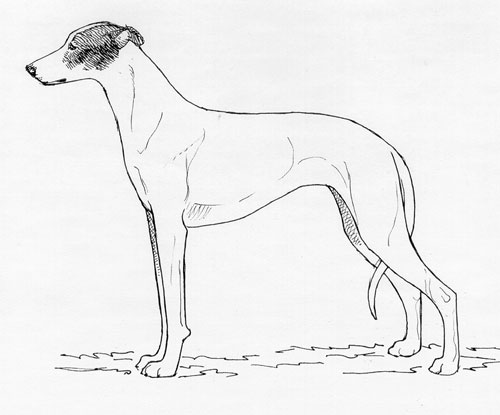Hungarian Greyhound (Magyar Agar)
Sighthound & Pariah Dog Group
The goals and purposes of this breed standard include: to furnish guidelines for breeders who wish to maintain the quality of their breed and to improve it; to advance this breed to a state of similarity throughout the world; and to act as a guide for judges.
Breeders and judges have the responsibility to avoid any conditions or exaggerations that are detrimental to the health, welfare, essence and soundness of this breed, and must take the responsibility to see that these are not perpetuated.
Any departure from the following should be considered a fault, and the seriousness with which the fault should be regarded should be in exact proportion to its degree and its effect upon the health and welfare of the dog and on the dog’s ability to perform its traditional work.
History
The Hungarian Greyhound is an original hunting breed, dating back to the time when the Magyars conquered Hungary. The breed was used for coursing game by sight, though it also has a good nose, and also for racing, at which it excels at long distances.
The Hungarian Greyhound was recognized by the United Kennel Club in 2006.
General Appearance
A strong yet elegant sighthound, slightly longer than tall, with well developed bone and musculature.
Characteristics
Fast, tough and robust, the Hungarian Greyhound is excellent on the racetrack. The breed is somewhat reserved by nature, yet not shy. It is sensible, intelligent and faithful, and makes an excellent companion and watchdog.
Head
Wedge-shaped, with a rather broad base, when viewed either from above or in profile.
SKULL
Fairly strong and broad, with a wide forehead and a pronounced stop.
MUZZLE
Long and strong, not too pointed, with muscular cheeks, well developed jaws and close fitting, well pigmented lips. Approximately the same length as the skull.
TEETH
The Hungarian Greyhound has a complete set of evenly spaced, white teeth meeting in a scissors bite.
Disqualification: Undershot, overshot, or wry bite.
NOSE
Large, with well opened nostrils and complete pigmentation.
EYES
Medium size, dark in color, neither sunken nor protruding. Expression is keen and intelligent.
Disqualifications: Entropion, ectropion.
EARS
Rather large, with thick leather being preferred to thin. Rose ears, carried thrown back in repose and raised up when the dog is alert.
Fault: Prick ears.
Neck
Medium long, elegant, dry and muscular, without dewlap.
Forequarters
The shoulder blades are long, mobile, muscular and moderately sloping. The upper arm is long and slightly sloping.
FORELEGS
Strong, straight and sinewy. The elbows fit close to the chest, but have free action. The pasterns are short and vertical.
Body
Slightly longer than tall in proportion. The chest is deep and distinctly rounded, giving much lung room. The ribs are well arched and reach well back into the body. The back and loin are broad, straight and firm, with strong musculature. The croup is broad, muscular and slightly sloping. The belly is moderately tucked up.
Hindquarters
The hindquarters are well angulated and powerfully muscled.
HIND LEGS
The legs have plenty of bone. They have long muscles. The stifle is moderately angulated. The hock joint is strong and well let down. Rear pasterns are short and vertical.
Feet
Fairly large, elongated, with strong pads and nails.
Tail
Set on at medium height, thick and long enough to reach to the hock. The underside is covered with wiry hair. In repose, the tail hangs down; in action, it is carried up, but not above the level of the topline.
Coat
Short, dense, coarse and smooth. In cold climates, a fair amount of dense undercoat may develop.
Color
All colors except blue, blue and white, brown, wolf grey, black and tan or tri-color. These colors are eliminating faults.
Height
Approximate height at the withers for males is 25.5 to 27.5 inches. For females, 24.5 to 26.5 inches. Height is less important than overall quality and balance.
Gait
A ground-covering, elastic trot, in which the feet do not converge towards a center line of travel.
Eliminating Faults
(An Eliminating Fault is a Fault serious enough that it eliminates the dog from obtaining any awards in a conformation event.)
The following colors are Eliminating Faults: blue, blue and white, brown, wolf grey, black and tan or tri-color.
Disqualifications
(A dog with a Disqualification must not be considered for placement in a conformation event, and must be reported to UKC.)
Unilateral or bilateral cryptorchid.
Viciousness or extreme shyness.
Albinism.
Undershot, overshot, or wry bite.
Entropion, ectropion.

Looking for a Dog?
Find a dog that will fit your family.
Note: The breeders on this list are not endorsed by UKC.
©Copyright 2006, United Kennel Club
